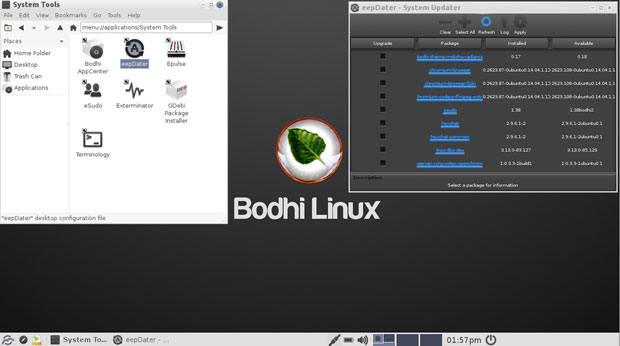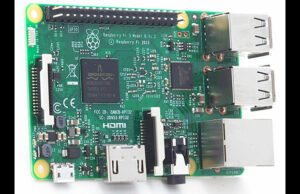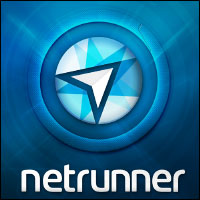
![]()
Bodhi Linux 3.2.0 is an update to the Bodhi Linux 3.x series and features key kernel and desktop improvements.
It is a different kind of Linux distro. Its developers refer to it as the “Enlightened Desktop,” because it draws its energy from theEnlightenment desktop.
Enlightenment started as a project to build a window manager for X11 in 1996. It became something much more than a window manager — it grew into a desktop environment in its own right. The Enlightenment Project is currently version 17, known as E17, and the Bodhi crew recently forked it.
This release of Bodhi uses the Moksha desktop. Both the distro name and its desktop moniker are Sanskrit terms. “Bodhi” means awakening or enlightenment. “Moksha” means emancipation, liberation or release.
Bodhi is one of a few Linux distros embracing the Enlightenment environment. Enlightenment is used in the Manjaro, Macpup and Elive distros, among others.
Until recently, Bodhi also ran the Enlightenment desktop, but the Bodhi developers lost faith in seemingly stalled advancements and misdirections from the Enlightenment community and forked it.
Bodhi Revisited
I lastlooked at this distro last year. I was very impressed with Bodhi back then. The latest version was released last month, and the improvements make Bodhi an even better computing environment now.
The project takes a minimalist approach by offering modularity, high levels of customization and choice of themes. In addition to basic 32- and 64-bit systems, Bodhi maintains designated ISO images for Chromebooks and legacy machines.
Moksha version 0.2.0 is a continuation of the Enlightenment 17 desktop. That is when the forking occurred. The latest version of the Enlightenment Compositing Window Manager and Desktop Shell is 0.18.7 or E18.
Moksha consists of the back porting of bug fixes and will include features from future Enlightenment releases, as well as the removal of half finished or broken things E17 contained, according to one of Bodhi’s primary developers, Jeff Hoogland.
Making the fork to Moksha from E17 was “a big step for the Bodhi project. Only time will tell if it is a good one or a bad one,” he said.
Enlightened Desktop
Like its desktop stepsister, Moksha is a lightweight design, so it runs of lots of legacy desktops and laptops. It also is very customizable.

Bodhi has the traditional Linux panel functionality. A button on the far left edge of the bar opens an uncluttered menu. Left click the mouse anywhere on the desktop to have that menu pop up at the mouse pointer. Press the Control +Alt+M keys to display that same menu wherever the mouse is resting on the desktop.
Right click anywhere on the desktop to bring up the favorites menu. Since there are no default applications, you must add your favorites first. Go to Main Menu > Settings > All > Apps > Favorite Applications.
Right click on the panel bar to get instant access to several configurations and setting adjustments. This is where you can add, remove or move gadgets that appear on the panel bar. First, however, you must load modules. To do so, go to Main Menu > Settings > Modules.
The Moksha desktop stores your collection of gadgets and launchers in shelves. You can arrange different shelves for different virtual workplaces. You can place configurable shelves anywhere along a border of the virtual desktop and can have multiple on the same desktop.
The right end of the panel holds system status icons for Internet connection, battery, clock and calendar, and shutdown options. A virtual workplace switcher already is set to display three workplaces. Keyboard shortcuts, called “bindings” in Bodhi, are very configurable. Quite a few shortcuts are set by default. You can add your own or change the existing key combinations.
Software Savvy
Bodhi has an unusual approach to its distro repository. At first, it looks like you use a standalone app called the “Bodhi AppCenter” to add or remove software packages. That is the traditional Linux method.

In actuality, clicking on the software center entry in the main menu launches the Chromium Web browser. The browser goes to the AppCenter section of the Bodhi website. There you search the repository for the desired titles and click the install button.
You also have an option to load separately from the Main Menu > Other the Synaptic Package Manager. Bodhi gives you a third way to reach the software center and other locations that traditionally are filtered only through the Main Menu.
Launch the PCMan File Manager, then click on Applications under the Places listing. Bodhi’s file manager integrates these functions as well.

I like Bodhi’s approach to system maintenance. Click on eepDater to run a well-tuned system updating application. It shows you all the installed packages and what updates are available for them. Click the check boxes for the ones you want to upgrade.
Loves Low Legacy
Bodhi Linux OS is one of the most forgiving distros you will find in terms of system requirements. It works on some really ancient legacy boxes.
At the bare minimum, you need a 500-MHz processor with 128 MB of RAM and 4 GB of drive space. However, the recommended hardware specs are a 1.0-GHz processor with 512 MB of RAM and 10 GB of drive space.
Unlike other Linux distros, you have more assessments to make before clicking on a download link. You have to match your hardware and your intended usage to the edition mated with those factors.
Usage Rundown
Bodhi Linux offers three ISO images: 32 bit, 64 bit and Legacy. The 32-bit and 64-bit images come in two flavors: Standard and AppPack.
If you are looking for a minimalistic base, get the standard release. It gives you no frills or unwanted software packages.
Instead, you get the base OS and add exactly what software you want to run on it. The standard release gives you a seven-package set by default.
You get the following:
- Terminology Terminal Emulator
- Midori Web Browser
- PCManFM File Manager
- ePad Text Editor
- ePhoto Image Viewer
- eepDater Update Manager
- ePulse Audio Settings
Your other option is a full-featured live CD offering that includes a variety of themes and default applications. That gets you the standard list of applications above plus the following:
- Chromium Web Browser
- LibreOffice 5
- VLC Media Player
- OpenShot Video Editor
- Pinta Graphics Tool
- Evince Document Viewer
- Qalculate Calculator
- Geany Text Editor
- Exterminator Task Manager
- Filezilla FTP Client
- HexChat IRC
- Synaptic Package Manager
- Printer Support
Wait, There’s More
Next, you have to consider your hardware. The 32-bit edition should work on the widest variety of hardware. It also will provide the best support for third-party closed source applications such as Steam and WPS Office. If you are unsure which Bodhi Linux image is your best bet, opt for this one.
If you are installing Bodhi to workstations or relatively new UEFI systems, go for the 64-bit edition. How about doing video or audio encoding, running virtual machines, using more than 64 GB of RAM or running a server? Again, grab the 64-bit edition.
The Legacy option is slightly different than you might think. It lacks PAE (Physical or Page Address Extension) support. Instead, it runs the older 3.2 Linux kernel that is optimized for old (15-plus years old) hardware.
Bottom Line
Bodhi Linux is elegant and lightweight. It is based on Ubuntu but runs only the forked E17 desktop. It is a very handy distro for those who like the idea of designing their own customized desktop look and feel. You literally have no bloat because you only add what you want to use.
Despite the kudos for Bodhi’s configurability, the relatively young desktop environment is devoid of much of the eye candy and animated niceties found in heavier-weight desktops such as Cinnamon and KDE. This is by design and is not a shortcoming. Bodhi is first and foremost true to its minimalistic philosophy.
Bodhi is very easy to use. It has a low learning curve; new Linux users can get acquainted right away. A Quick Start wiki automatically loads on first run.
You caninstall Bodhi as a dual boot on a Chromebook.
Want to Suggest a Review?
Is there a Linux software application or distro you’d like to suggest for review? Something you love or would like to get to know?
Pleaseemail your ideas to me, and I’ll consider them for a future Linux Picks and Pans column.
And use the Talkback feature below to add your comments!

















































Thanks for the review. It is good to see someone offer info to help new users of this DE get started. I also wanted to mention that Enlightenment is up to e20 and there is an e21 beta out right now. Also, the Chromebook image at its newest is only available for bodhi 3.0.0. This post by Jeff http://forums.bodhilinux.com/index.php?/topic/13049-bodhi-31-chromebook-iso/?hl=chromebook suggests the 3.2 release will support the Chromebook by itself. Due to the kernel update. We should be getting 4.0 in 6 months or so based on the newest LTS release from Ubuntu.
Review gives me most if not all the mandatory points for updating since last time I tested the enlightened Linux OS (arround Bodhi 2.3).
Enough to try it again, and possibly install it on the demo desktop I’m setting up at the local DIY Neighbors House.
Kudos for a clear review!